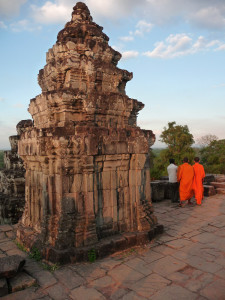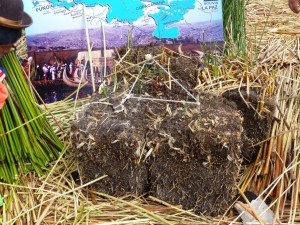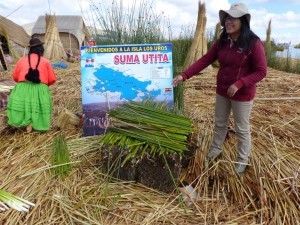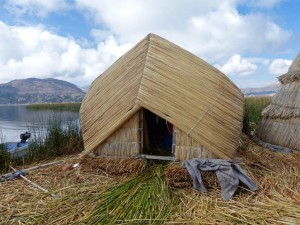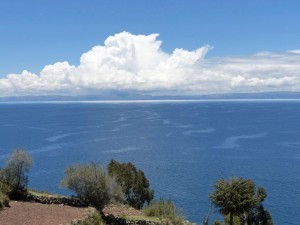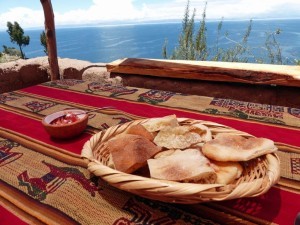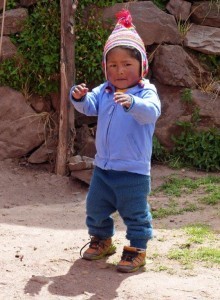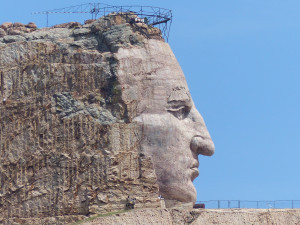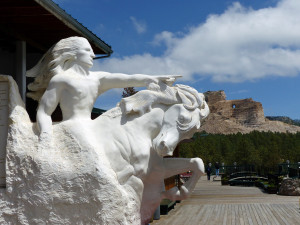Jennifer Burge's Blog, page 3
April 29, 2016
The Secrets of Port Arthur

Historically speaking, let’s leave that microscope in the drawer, shall we?
Lately, I’ve had a major realization of just how many people aren’t interested in the truth of a situation, past or present. Times change. Some cultures adapt and others do not. The one thing that doesn’t seem to change, however, is the inclination to change the cover story of a distasteful situation. Whether we are talking textbooks or personal biographies, the tendency to sugarcoat is rampant—and humans have been doing it for centuries. A visit to the famous former prison colony in Port Arthur, Tasmania and a look at its history reveal some stark truths about humanity.
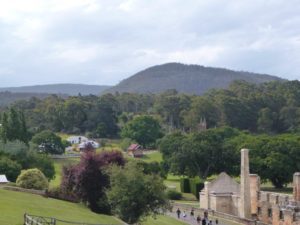
View over Port Arthur
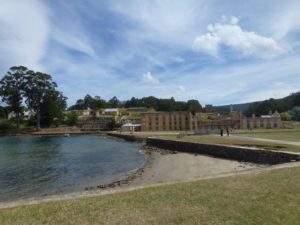
View of the convict buildings at Port Arthur
I know I’m not alone in admitting I had forgotten that Britain was transporting its convicts to the American colonies for seventy years prior to changing the destination to New South Wales. When I first began to learn about the convict history of Australia, I was fascinated. Of course I had learned about “transportation” to the New World from Great Britain in American history books, but it is different to walk in the actual footsteps of these unfortunate (if sometimes evil) men and women. American history books do not expand at length on the fact that from 1718-1775 over 54,000 British convicts were sent to what is now the United States. Even Thomas Jefferson downplayed this in 1786 claiming the number was less than 2000. Apparently he was more talented with words than with numbers.
Prior to moving to Australia in 2011, I visited several historical sites dedicated to the story of the convicts in the First Fleet and the environment in which they found themselves nearly 10,000 miles from home. It was intriguing to learn that they were shipped on disease-ridden “hulks” which measured the size of six buses and carried three hundred men each and how they adapted to this harsh and wild land. Their stories are similar, often making modern-day readers cringe at the cruelty of being dispelled from one’s homeland for stealing food to survive. The British officers who led these convict colonies are revered for their stalwart bravery and stern leadership. In 2012, I visited Port Arthur which lies 37 miles from Hobart, the Tasmanian capital, and learned there was much more to the story.
A former lumber station, Port Arthur Prison opened in 1833. Its location as an “inescapable” prison was deemed perfect. The idyllic grounds are accessible only by traversing the one hundred foot Isthmus of Eaglehawk Neck. The elegant home of the Commandant is placed high on a hill and faces the waters surrounding the prison continuing the illusion of serenity.
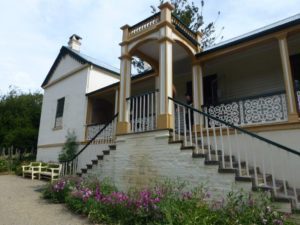
The Commandant’s House, Port Arthur
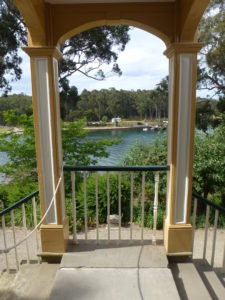
View from the Commandant’s House
The bright green pastoral setting is completed by pink and purple wildflowers that reach for light in between the giant sandstone buildings built by convict hands. One look from behind the barred windows provides one with a very different perspective of life at Port Arthur.
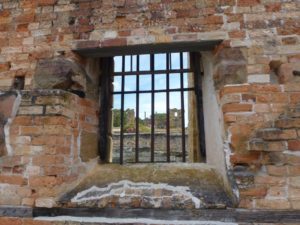
View from the inside of a convict building at Port Arthur
Port Arthur housed the harshest of the transported criminals, those who re-offended after being brought to Australia. Initially punishment focused on physical labor and corporal punishment. Convicts worked at gathering lumber, shipbuilding, and shoe-making. When they behaved well, they were afforded small luxuries as a method of positive reinforcement. If they didn’t, life became a living hell. All in the name of reform, of course.
After roughly fifteen years of the same practices, the British government decided to experiment. Wouldn’t punishing the mind be more effective than punishing the body? If prisoners were left no way of escaping the reflection of their heinous crimes, wouldn’t the result obviously be a reformed man? A distant cousin of the model being implemented in London at the same time, Port Arthur built a “Separate Prison.” Offenders in this model were kept in complete silence at all times. They worked and slept in their cells, receiving only one hour outside every three days.
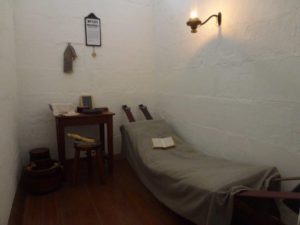
Inside the cells of the Separate Prison in Port Arthur
Upon leaving the cell, prisoners were hooded to prevent recognition and communication with fellow inmates. Men were identified only by numbers on their uniforms. One step out of line brought another level of misery. The “dark cell” was a form of solitary confinement where inmates could be detained for up to thirty days. Voices could be used only in the chapel–to sing hymns.
I wasn’t surprised that as a result of this experiment, the Lunatic Asylum on the grounds had to be expanded. Men were also known to commit murder to escape this hopeless existence in which the prison was the whole world and not merely four walls.
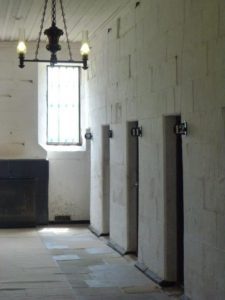
Cells of the Separate Prison, Port Arthur
In 1877, the prison closed and Port Arthur’s buildings sat empty for decades. Tasmanians were (understandably) not interested in reviving the dark past of the location, even changing the name of the town to Carnarvon before it reverted back to the original in 1927. Many people, myself included, are interested in man’s capacity for evil—no matter which side of the bars those men are on. Ghost stories persist about the surviving buildings that were saved from destruction and today the site is preserved by a historical society and managed by the parks service.
Even once a bistro and a boat ride were common highlights for visitors, there would be a last dark chapter for the people of Port Arthur. On April 28th, 1996, a man named Martin Bryant went on a shooting rampage in several buildings across the site’s grounds. He murdered thirty-five innocent people that day and injured dozens more. Bryant now resides in the psychiatric wing of Risdon Prison in Hobart serving thirty-five life sentences and 1035 years without parole. In the wake of the incident, the Australian government passed legislation to tighten the laws of ownership surrounding self-loading weapons. The incident remains the most devastating gun massacre in Australian history.
Though convict history was not initially embraced by Australians, it is now preserved as a crucial period of the evolution of Australia. Many of the men who were transported here went on to become free settlers with the skills they acquired while incarcerated. These are the first Australians in modern history and today having one of them in your family history is more fashionable than disgraceful. There is no disputing that the British convicts were not the first humans to live on what is now Australian soil, but it is their legacy that built an industrialized society. There is no doubt that it is the end result that will be remembered by historians, not the steps taken to get here.
The post The Secrets of Port Arthur appeared first on Worldwise Publications.
April 20, 2016
To Be or Not To Be: An Aussie
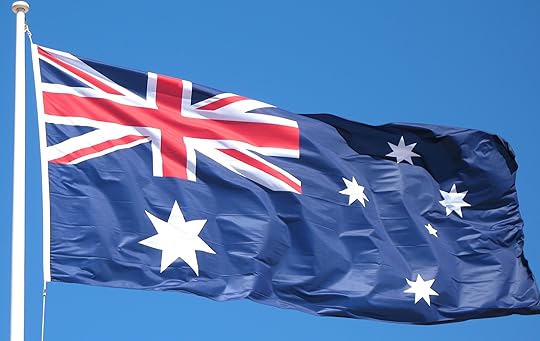
Next month, it will be five years since I moved to Australia. It is my fifth country of residence. The idea of obtaining Australian citizenship was once as far-fetched as landing here to begin with. The path that led me here was anything but simple; a year in Germany, five years in The Netherlands, and four years in Singapore came before the “Lucky Country.” Nothing would make me happier than to say that once I landed in the Land Down Under all was well. I’ve spent the past few years documenting the difficulties of my peripatetic life, but there have been triumphs as well. But to declare that I have found my space, my tribe, my happiness in a place so unexpected is another matter entirely.
There was a honeymoon phase to be certain. Freedom from the oppression that plagues Singapore was a single drop of rain in the hurricane of happiness. Brisbanites asked, “How are you handling the humidity?” After life less than two degrees from the Equator, I wanted to say, “What humidity?” Australia is a vast open land of natural beauty. The only examples of natural beauty in the city-state were the carefully constructed, curated gardens. Beautiful as they may be, there is simply no comparison to the island nation I now call home.
As always, the infatuation fades and reality surfaces. I was fifteen thousand miles from most of my friends and the city I grew up in. In time zones, that equates to fourteen or fifteen hours of time difference–depending on the time of year. Despite the fact that I had spent a month in Sydney before making the decision to move to this country, I found I didn’t understand the people or culture at all. On the surface, we both have Anglo-Saxon roots and speak the same language. In reality, we could not be more different from one another in culture, experience, or global perspective. Why I would have thought differently about two places which evolved in opposite regions of the planet is beyond me.
To be fair, this is the first time that I have lived anywhere other than the United States long enough to obtain citizenship. I had the opportunity after five years in the Netherlands, but when I posted my application to take the test to the address on the immigration web site, it was returned. The address had changed and was not yet updated online. Nor was there a new address included with the returned documents. Shortly after my application was returned, I learned that the hoped-for opportunity to relocate to Singapore was approved. The trial of language and culture testing was suddenly irrelevant. I would be lying if I said I wasn’t relieved.
Flash forward to February 2016. I discovered quite by accident that I was eligible to complete the final obstacle to moving from Australian permanent residency to Australian citizenship. With that knowledge came the barrage of unbidden, nagging questions: Did I want to become “Australian”? Would that mean I was no longer “American”? Was I a traitor to my birthplace—the nation where I was raised and educated? If I proceed, am I leaving my Dutch husband (whose country doesn’t allow dual citizenship in all circumstances) behind somehow?
After fifteen years overseas, you begin (insanely) to believe that you have this game figured out. But is it possible to “figure out” a question which relies so heavily on the heart for an answer? It’s no secret that I love this country, but is it even possible to adopt a new homeland when you aren’t forced to by war or another tragic circumstance? And if those things aren’t a factor, when why would you?
A few reasons:
Because you can
Because the entire world is making immigration more and more difficult
Because the years you have been gone have eroded the ties you left behind
Because, like everyone else, you want a secure future and a better life
Because you feel accepted in the adopted country
Because you feel misunderstood in the one you were born in
Because you have seen enough of the world to know a good thing when you see it
Because the new country welcomes you
Because your desired lifestyle is realistic in the new country, not an unachievable ideal
Because the only thing that matters is now
Of course I can go on. I could say that my dream in life was to life in a place with more beaches and islands than I will ever have time to visit. I might also tell you that I have never had more unexpected adventure in a country despite the many I have “tried on” and I know that life will never ever be boring here. Pythons in the driveway. Koalas in the back yard. Need I say more?
Many people who have read my books tell me that it’s all about “culture shock.” Well folks, I’m here to tell you that culture shock is only part of the equation. You see, once you get around a fair bit, it becomes blatantly obvious that not every country is a fit for every personality. Simply put, some places are more “home” than others will ever be, regardless of the duration of your stay. I had no true desire to become Dutch, German, or Singaporean—but Australian is a label I will wear proudly. My years here have been far from perfect, but they have brought me closer to it than I would ever have thought possible.
The post To Be or Not To Be: An Aussie appeared first on Worldwise Publications.
March 23, 2016
Keys to the Kingdom
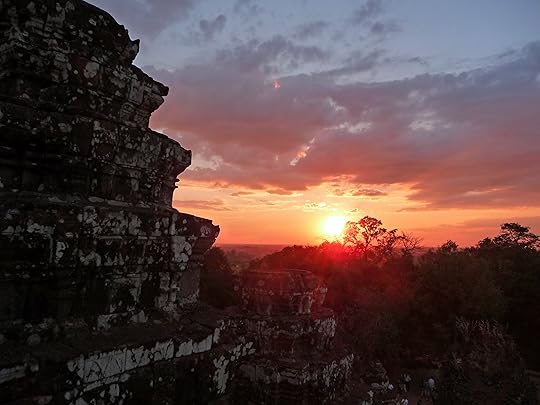
Is there anything more intriguing than a “lost city” rediscovered? I doubt that I am the only one that loves pondering a good mystery like the fate of the Mayans or the original purpose of Machu Picchu. Perhaps it’s only to compare the downfall of former great civilizations to our own existence here on planet Earth and what lies in store for our future, but I can’t turn down a good documentary on the subject. If you ask my husband, he’ll tell you they often lead to a bout of intense travel planning and are best avoided. That’s probably why he fled the room when a television program about the Kingdom of Angkor recently began.
The trip we took to Cambodia and Laos was an all-time favorite, especially the time we spent in Siem Reap, the gateway to Angkor Wat, Angkor Thom, and the Kingdom of Angkor. Though this capital of the northwest Cambodian province houses, feeds, and entertains more than a million tourists per year, it maintains a “village” feel. There are numerous resorts to pick from and plenty of ways to visit the thousands of incredible temples being preserved here, but the dusty streets and warm locals welcome you as a friend. A friend with money, perhaps, but a friend nonetheless. Sadly, there were also more street children here than other Asian cities—many more—but their beautiful faces would depart upon hearing the word “no.” Knowing a few dollars would make a very big difference to a family, I often wanted to say “yes” to a package of postcards I didn’t need, but we were warned ahead of time that if the children make much money this way, they believe they don’t have to go to school. I’d rather a disappointed face for a few minutes over a lifetime of it, so I heeded the warning.
Friends who had made the trip before us reported being “templed-out” after a few days, so we tried not to rush through these works of art without appreciating their unique details. Another bit of good advice we received was to hire a guide for our days in Angkor. That and an air-conditioned van made the excursions much more pleasant. The fierce sunlight and excessive humidity take their toll quickly and the ability to chill out between stops helped us revive enough to listen to the tales spun by our guide Bona. The master stroke behind hiring a guide, however, was his knowledge of the area. He knew when busloads of tourists would arrive at a particular spot and would whisk us away to another temple for a more secluded visit. A few dollars a day have never been so well spent.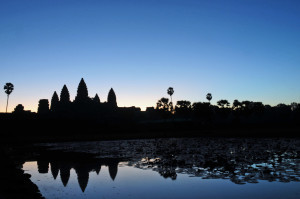
In fact, the crowds were the only downside to the entire visit. We arrived a few days before Christmas which is prime-time for global travel and our fellow adventurers were rarely far behind. We woke up at 4:30am to make the trip to the ruins to see the sun rise into a purple-pink sky over the miraculous reflection pool in front of Angkor Wat and Bona made sure we arrived before the masses. My husband set up his tripod a few feet back from the water’s edge and as we waited for sunrise, we watched every available inch of grass become covered with other tourists. My normally mellow hubby was fuming when a Korean family moved in between us and the water—blocking his camera shot entirely. By the time we tried to move, it was a free-for-all. Women shouted to husbands. Boyfriends unpacked enormous camera lenses. The line of tents selling food and trinkets behind us completed the circus-like feel. But the best thing? You can’t tell any of this from the beautiful photos we walked away with.
Similarly, we climbed Phnom Bakheng, a mountain-like active Buddhist temple, late one afternoon to watch the sun set over Angkor Wat. We were quite early, but the masses were ahead of us this time. By the time we reached the top, it was difficult to find a few feet of stone to perch ourselves and our cameras. Thankfully, the vibe here was different from the dawn event and people maintained a quiet reverence due to the presence of the monks. Watching the sky turn orange, just like the robes they wore, was a religious experience—one I will never forget.
There are far too many temples to mention here and your guide or guidebook (in my case, both!) will help you tremendously in determining which ones to visit. Want to see where Angelina Jolie stood filming Tomb Raider? Right this way! Interested in the Terrace of the Leper King? Jump in! One thing you will not be in Siem Reap is bored. Opportunities to explore are endless and there is always someone nearby to show you the way. For a quick read, you can learn about the major attractions here.
This precious collection of artifacts and temples dating from the 8th century is a marvel of mankind’s ability to create. Visiting the various collections of temples allows you to see the development of a civilization and track its advancement. (A comprehensive list of temples and dates can be found here). They become more intricate and sophisticated as the centuries pass—but there is an abrupt end around the year 1431 when the Angkor Civilization (also known as the Khmer Empire) collapsed. The story of the empire, written in detailed Sanskrit, can be traced throughout the kingdom, but in the middle of the fifteenth century, the trail disappears.
Since the “re-discovery” of Angkor by a French naturalist in the 1800’s scientists have been scratching their heads over the cause of their disappearance. One of my beloved documentaries only recently delivered the most plausible theory to date. Angkor continued to develop over time and at its peak, it comprised most of Cambodia, central Thailand, southern Viet Nam, and even areas of Laos. When the early civilization developed, the climate delivered the best possible conditions. Later, in the 13th century, there is evidence of severe drought. The Khmer developed an effective irrigation system to combat the problem, but the drought conditions persisted. By examining tree rings in the area, scientists know that relief came after several years, but drought returned and worsened the next century.
Finally, water did begin to fall from the sky to the parched land and people below. In fact, it began and never stopped. The years of drought were followed by massive monsoon rains which, due to the extensive irrigation system they had built, destroyed the city. Warring factions in the area and political instability are thought to have contributed to the downfall of this majestic empire, but it appears that climate change was their Achilles’ heel.
So, to review, a highly-sophisticated civilization which was at the time one of the most advanced in the world was brought down by its own ability to solve potential crises and by extreme changes in climate that they could not control. Does this story sound frighteningly familiar to anyone? It certainly does to me.
The post Keys to the Kingdom appeared first on Worldwise Publications.
March 19, 2016
Singapore Salvation Catches Fire!
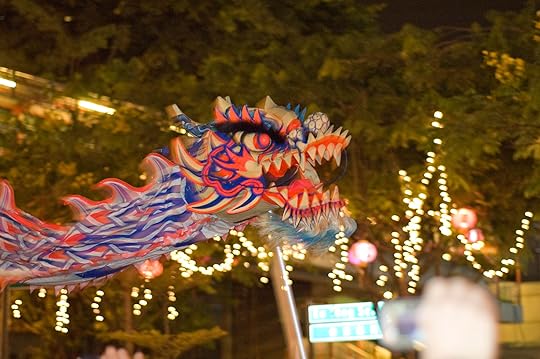
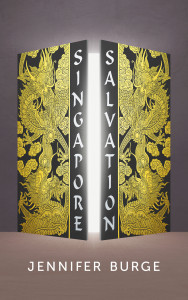
REVEALING ACCOUNT OF THE DESTRUCTION OF ONE WOMAN’S PERSONAL AND PROFESSIONAL IDENTITY AMID ASIA’S CULTURAL QUICKSAND
Jennifer Burge understands the challenges of life abroad. Having documented the pitfalls of taking her career from the United States to Europe in her first memoir, The Devil Wears Clogs, it’s hard to imagine she would be confounded by the complexity of another foreign culture—yet that is exactly the case. Her understanding of Asian tradition is a mirage appearing and disappearing with each new interaction.
Jennifer’s second memoir has left readers clamoring for a third.
R.R. Marinelli (Melbourne) writes that Singapore Salvation puts a match to popular misconception: “Singapore Salvation tells it as it is. From the outside the expat life may appear to be glamorous and oh so easy. It is far from it. The author shares her personal experiences to give an honest account of what lies beneath the surface of this much desired lifestyle.”
H. Albrecht (Germany) “If you have been working abroad and lived amongst different cultures yourself – this is a must read. A truly gripping story. It is always fun to follow Jennifer’s trips and her insightful travel tips. I wonder what she is writing about after Australia.”
Alessandra (Brisbane) says this about Singapore Salvation: “A stripped-back honest account of the many valleys, self examinations, and mountain highs while living a modern day nomadic lifestyle in the Far East. Anticipating the pen of her Australian experience.”
K. Stahl (Atlanta) comments: “a wonderfully descriptive and insightful book. It is not only an insider guide to travel in Asia, but also a heartfelt narrative of a marriage tested by the strains of employment and international moves. A must read for any world traveler or stay at home dreamer.”
About the Author:

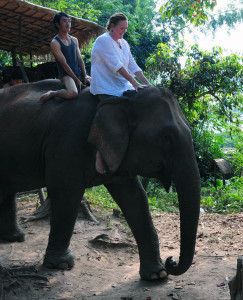
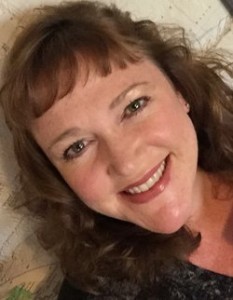
Jennifer Burge grew up on the Lake Erie shore near Cleveland, Ohio. Graduating from the Ohio State University in 1994, she long dreamed of living and working in Europe. Her wish came true as her career in IT project management moved her to Germany in 2001 and then to the Netherlands in 2002.
In 2007, Jennifer relocated to Singapore where she worked as an IT contractor. She traveled extensively throughout Asia and began writing destination pieces for The Guide magazine (Vietnam). Realizing that others who sought to work overseas could benefit from her first-hand experience and perhaps avoid painful lessons, Jennifer began writing her memoir, The Devil Wears Clogs, in 2009.
Her next move took her to Australia in 2011 where she returned to consulting before taking the leap to full-time writing in 2012. In 2013 and she became a full member of the Australian Authors’ Society and her first memoir was published in late 2014. Singapore Salvation, the Asian sequel, was released in early 2016 and the Australian tale will complete the series in 2017.
Jennifer lives in north Brisbane and works full-time writing and speaking in the importance of cultural understanding in a global society. She is a columnist for ExpatFocus.com and provides insight on world destinations and cultures at WorldwisePublications.com.
Visit www.worldwisepublications.com/media/ for contact details, review copies, photos, and author interviews.
Facebook Page: https://www.facebook.com/SingaporeSalvation
The post Singapore Salvation Catches Fire! appeared first on Worldwise Publications.
March 9, 2016
Cooking Up a Storm
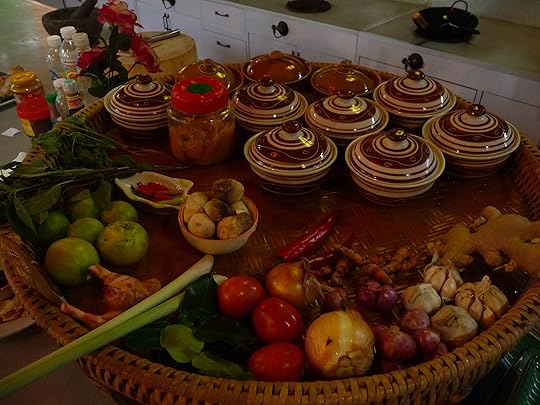
The gods were not happy about my decision to enter a kitchen. It wasn’t expected. It wasn’t natural. The whole situation was unpredictable. But Mr. Roi of Roi Thai Cooking School is a brave man. He took me on as a student despite the gale force winds that kicked up that morning, ignoring the warnings from above. I was on Ko Lanta, a quiet island in the Andaman Sea in the Thai province of Krabi, having just arrived from the party island that is Ko Phi Phi. Wild weather or not, it was a welcome change.
It was October of 2010 and I knew our Asian time was coming to an end. In just over six months, we would relocate to Australia. The challenge was on to make the most of the time that remained. I headed for Krabi because of the stunning emerald seas and serene bays filled with fine white sand. One of them, Phang Nga Bay, was made famous by in the film ‘The Man with the Golden Gun’ but that was merely a taste.
I traveled first to Ao Nang, which is strikingly un-beautiful given its location. From there, I braved Phi Phi and found it was not my cup of lassi (mango lassi is a delicious yoghurt-like drink that is popular with Thailand’s spicy dishes). The beaches are just as spectacular as all those Google images show, but the general vibe made me uneasy. I wasn’t a twenty-something diver with an unlimited supply of energy for drinking and dancing afterward as most of the island-goers were. Even when relaxing at a resort on the other side of the island, it is impossible to ignore the nightlife symphony. Though I felt fortunate to have the opportunity to see it for myself, I was more fortunate to move on.
Then came the sleepy island of Ko Lanta. There is simply no comparison between this island and the others nearby often overrun with tourists. There is a quaint central village with a few small shops and restaurants. Along the many pristine beaches are several low-key resorts. I’m convinced I was the only guest at the one I chose, soaking up delicious gourmet coffee in peace & quiet–interrupted only by frogs with inordinately large vocal cords. This was the true paradise I’d been seeking.
Riding along in my rented moped, I visited the brand new tsunami shelter. Never used, it had obviously been constructed after disaster struck on Boxing Day 2004. No one was there, but a smiling god grinned down at me from the archway to let me know I was safe on this island of only 80 square kilometers (30 square miles). Hoping the shelter would forever remain unused, I left to discover what else I might find on Lanta’s only main road.
Funny that the storm hit just as I discovered Roi Thai Cooking School. It’s a bit like those jokes people (like me) make when they speak of attending a church service after a very long time between visits—cue the spontaneous combustion, mass explosions, earthquakes—only it was no joke. I had very little idea what to do in a kitchen at this point in my life, let alone one in Thailand!
But as I said before, Mr. Roi was fearless. I wasn’t sure when he handed over the pink-tinted protective eyewear for me to put on, but that turned out to be foreigner lesson #1: Thou shalt not chop red chilies and onions without covering the eyes! Now, of course, I do it all the time. In 2010, I didn’t know what to do with a chili other than try not to consume one.
Foreigner lesson #2: Pay attention! Open flames, multi-colored paper lanterns being tossed about in the wind, and ingredients that will send fire all the way to your toes can be a lethal combination. Though Mr. Roi did not show any trepidation, I was certain I was fooling no one with my complete lack of culinary talent. Eventually, I simply asked him, “Do most of the people who come here already know what to do in the kitchen?” The answer? A nod and a laugh.
Much to my surprise, however, the dishes I prepared looked quite beautiful. Had you not seen the process, you might even guess that I was experienced in the craft of making papaya salad, satay with peanut sauce, and chicken with homemade red curry paste. It might also be that the beautiful colors and tantalizing scents of Thai food make it attractive no matter who makes it. Chefs do not share their secrets so I’m afraid I can’t comment.
Even though I didn’t have a clue what to do without the expert advice of my quiet patient teacher, I had a great time. The food was delicious. I learned how to make Thai staples that might impress someone who hadn’t done it before. Then again, they might not. The key was that I had surprised myself and had fun doing it. So the next time you’re in Thailand and the heavens prevent you from spending your time on the sea, check out one of these schools for sheer joy of trying something completely different. If you are one of those expert chefs, however, please stand clear of the kitchen. Explosions are still known to occur without warning.
The post Cooking Up a Storm appeared first on Worldwise Publications.
March 2, 2016
Peruvian Pearls of Wisdom
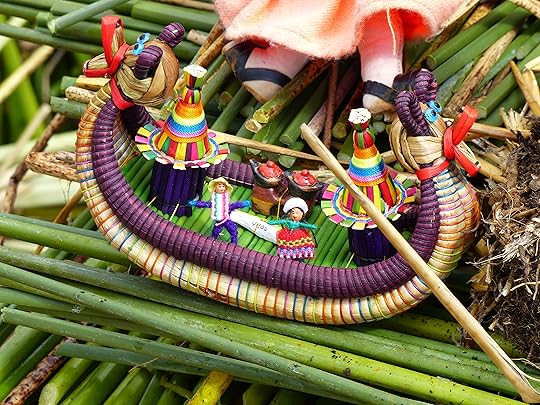
For the second time in two decades of travel, I hired professionals to plan our journey through Peru in 2014. Machu Picchu had been a dream as long as I can remember with the Amazon rainforest running a close second. Beyond that, the extent of my knowledge of Peru was limited. The biggest factor in hiring a travel company was the discovery that it wasn’t deemed a wonderful idea to drive yourself as a visitor in Peru and in fact many tourists have died doing so. It was clear we needed help to navigate this massive country.
The reason I don’t normally use professional travel services is because you are then (obviously) a step removed from the planning. Adding in the complexities of operating in a language that isn’t your native tongue or the planner’s and you are now miles from the details. In my particular case, I will admit that I didn’t worry a great deal about this. A friend of the family and former Peru resident provided invaluable connections to Condor Travel. I could continue freaking out about my first book being published because I knew I was in good hands in Peru.
But why I am I telling you all this? So it won’t seem ridiculous when I tell you that the islands we visited outside of Puno were a complete surprise. Yes, I had read and agreed to the itinerary. Most of it had been based on my requests. These little gems that were added on after the amazing Amazon and crazy Cuzco weren’t my idea. When the question was raised about seeing the “world’s highest navigable lake,” I enthusiastically agreed. What that meant couldn’t have been more of a surprise.
The “grey puma” in Quechua, Lake Titicaca is 8000 square kilometers of serene silver beauty. Nearly cut in half by the Bolivian border with Peru, it has about forty islands spread throughout it. Our one day journey from Puno allowed us to visit two of them: Uros and Taquile.
Thus far on our travels, we’d learned a great deal about the Incas and the invasion of the Spanish conquistadors. Now we were getting a glimpse of pre-Inca culture. As explained by our tour guide Lily, the Uros had fled to the middle of Lake Titicaca to avoid fighting the fierce Inca warriors. To do so, they built their own islands. If your next question begins with “How on Earth..?” then you and I think alike. The islands are built from totora reeds—thick layers of sturdy reeds keep the islands afloat. The houses are also built from reeds. The beds are built from reeds. Transportation is built using reeds. No, I am not pulling your leg.
So if you’re thinking now about how far-fetched this sounds, consider the fact that the Uros have been living like this for hundreds of years. Not only that, they have been allowing tourists to visit since the 1960’s according to Lily. I honestly don’t know how something this unusual had escaped my attention for the whole of my existence, but it had. Until the moment I placed one unsteady foot on the precarious island surface wondering if I would shoot straight through the island to the water below, I would not have believed this lifestyle existed. Since seeing is believing, check out this fabulous photo essay from the Washington Post.
Walking on these islands (mostly moored about five kilometers offshore of Puno) is the oddest sensation you can imagine. When they aren’t entertaining and educating tourists, the local people are hard at work fortifying the reed islands constantly to keep them afloat. We were taken inside the home of one family and astonished to find, along with a squishy bed, a small black-and-white television set connected to battery power. The bathroom, a small single-purpose island out back, was slightly less luxe. As fascinating as it was, being there made me nervous. Our hosts could not have been friendlier or the children more adorable, but reed living is not my cup of tea.
The next stop, Taquile Island, was a further forty kilometers from shore. Lake Titicaca, blue glass in late October, delivered a smooth ride. Though I was relieved to place my foot on solid ground, I was less delighted to be directed up a steep set of hundreds of stairs. We were now nearly thirteen thousand feet (4000 meters) above sea-level—breathing was more than just “difficult.”
Surrounded by the most incredible views of the lake I could imagine, I listened to Lily describe the history and lifestyle of the Taquile people. There are no police here on the island of world heritage-listed woven handicrafts and the island is divided into sections for crop rotation. The steep island is perfect for terraced farming and potatoes are a main crop.
Closer to the town’s main square, we stopped for a local lunch. A stone patio had been constructed for entertainment and meals and we took our seats at a picnic table overlooking the lake with the sun warming our backs. Steaming homemade bread and cold beer were quickly laid out on the scarlet-and-maize woven tablecloth. A smiling young man asked if we would like omelets or fish. The atmosphere could not have been more comfortable and being on solid ground was only a small part of it. Soon we were clapping along to a folk dance performance.
Beautiful handicrafts were admired and purchased on both islands as I considered the difficult choices that lie ahead for these traditional cultures. On Taquile, it had been difficult to reach mainland Peru until the 1950’s so they had learned to self-govern—but intermarriage and breeding had not come without costs. The Uros had landed in the middle of the lake after being shunned by other cultures—both invading and indigenous. Would their path be any smoother now that their islands had become a carnival of sorts that catered to a stampede of tourists? Probably not. If my purchase or visit contribute to the education of their children in any way, I’ll display my brightly-colored Uros wall-hanging with absolute pride.
Far be it from me to believe I have the answers, but I find it heartening to see that they are surviving as best they can while staying as true as possible to their unique heritages in the modern age. To be perfectly frank, what choice do they have? To vanish into oblivion under the staggering weight of substance abuse the plagues so many native peoples? To construct huge casinos to fund a future that looks nothing like the one they envisioned for themselves in their hundreds or thousands of years of existence? Looking back at my photos brings the familiar dread in the pit of my stomach. I don’t think it comes from fear of crushing the reeds after all.
Note to travelers: Want to know more about reed living on Uros? You can even stay overnight here now.
The post Peruvian Pearls of Wisdom appeared first on Worldwise Publications.
February 10, 2016
Magnetic Moreton Island
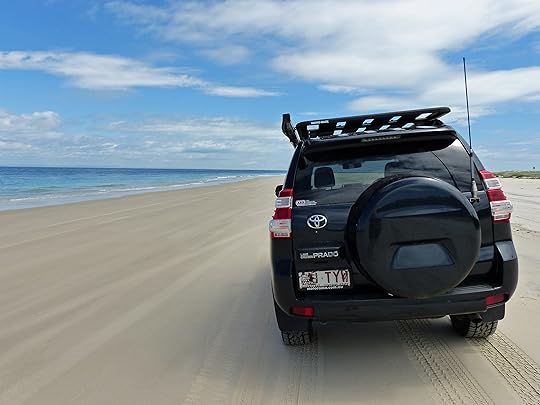
In February of 2015, there were many cries of “Marcia Marcia Marcia!” (insert Brady Bunch theme here) as Tropical Cyclone Marcia steam-rolled our plans for summer fun. A dear friend from Connecticut was visiting and we had a special Moreton Island camping trip planned to celebrate his birthday. Instead of wading in crystal-clear waters and four-wheel driving kilometers of sand roads, we sat in my kitchen drinking wine and playing Trivial Pursuit. It was hardly the birthday escapade we hoped for.
After speaking with the park rangers on Moreton Island, the world’s third largest sand island which is 58 kilometers off the coast of Brisbane, we canceled our pass for the vehicle ferry and our campsite. In the no-bullshit Aussie style I have come to love, he said we could probably get to the island–getting off it in cyclone conditions would be the challenge. Being stranded out in the open in gale force winds and driving rain was outside our camping party’s tolerance for adventure.
One year later, this ferry pass loomed over my husband and I. When would we actually have time to use it? With my workaholic husband’s current schedule, the answer was “never.” It was a hundred and fifty dollars for the passage to this reported island paradise just over an hour from home. It wouldn’t break the bank if we lost it, but something kept pulling me towards it. “What’s the problem?” you ask. “Why not just go by yourself?” you’re wondering. Well, as with everything in Australia, there was a hitch.
This extremely large island of sand has no roads. Well, it has roads, but they are also sand. It is inaccessible to regular cars and requires a four-wheel drive vehicle to traverse its 72 square miles of pristine natural beauty. I have driven on the beach. I have even driven in some fairly nasty conditions. But did I want to do it on an island, alone, in remote areas? Areas where there would surely be no phone signal available should I need to call for help? There are a few too many exclamation marks of caution on this Moreton Island Driving Map.
But because I am me, the answer could be nothing but “yes.” Perhaps it was my inability to admit defeat by something as silly as no roads to drive on, but honestly, it felt like something more. I was being pulled to this island by a force I cannot explain. Sure, I’m a beach fanatic and nature-lover, but I’m surrounded by islands that are very beautiful and a hell of a lot easier to get to. Why shatter my nerves with this one? I had no answer.
I drove off that ferry in a state of shock. I didn’t know for sure what the tide situation was (despite having a tide table with me) or how far I had to go from the ferry landing or what the conditions were like on the island. I just followed the guys in front of me knowing that in their tracks was the safest place to be. Our Toyota Prado held strong, thankfully, and though its contents were thrown around, the thirty minute drive to Bulwer from Tangalooma was easier than I expected.
When I reached Castaways where I was renting a unit, I began to relax. As it was the hottest day in Brisbane so far this summer, I immediately stripped to my bathing suit and went for the beach–by foot. Bulwer is the site of a famous shipwreck, so in this clear-as-glass water, it was easy to see a million tiny fish just a few feet offshore. Pardon the pun, but I was hooked in seconds. I floated the afternoon away on that beautiful spot and later spied a stunning sunset.
Little by little, I was emboldened by the fact that I hadn’t gotten stuck in the sand. I’d lowered my tire pressure as the locals advise for a better grip on the tracks and I was only having near heart-attacks when the wheels began to spin occasionally – not full-blown ones. One morning, More than one morning, I was the only soul at Comboyuro Point and could see no one for miles. Further afield, I took a dip in the aptly named Champagne Pools at magnificent North Point. I never found the Blue Lagoon, but I did find new respect for my own ability. Missing out on this absolute treasure would have been a travesty. Now that I know I can do it, where else will I go? Oh my poor husband.
Later, reading about the history of this location, I was stunned by its story. Three escaped British convicts were marooned on Moreton Island in 1823. They lived like natives for over seven months and became friendly with the local Aboriginal tribe who they credit with keeping them alive. Eventually, these men left Moreton and headed north where they thought they would find Sydney, but they’d gone the wrong way. After much trial and arguing, they ended up turning round and returning to the mouth of a large river they had set eyes on previously. They landed again on what is now Bribie Island.
Months later, the remaining men were cooking up their catch of the day on the beach when a ship sailed into the bay. Imagine the shock of British explorer John Oxley when a man speaking perfect English greeted him with his local Aboriginal friends on November 29th, 1823! The escape convicts were rescued by Oxley and they led him to what is now the mighty Brisbane River. These men were the first white men to see what would become modern-day Brisbane—my hometown.
Oxley took the men back to Sydney where one of them later committed another crime and, in a stroke of supreme irony, he was sentenced to seven years at the newly established Moreton Bay penal colony. On the explorer’s positive report, a colony for the worst repeat offenders had been established there. This colony was the precursor of what is today the capital of Queensland.
Though my surroundings were wild, my living conditions were luxurious in comparison to the castaways for whom my accommodations were named. I feared getting bogged in the deep sandy tracks while they feared for their lives on a daily and sometimes hourly basis. They crafted their own wooden canoe where my biggest concern was whether the tide was low enough to drive back to the ferry. But their rescue date–November 29th–is also my birthday. My interpretation here is that I was meant learn this story. Having my city’s roots revealed from this incredibly unique perspective only serves to increase my curiosity about the land I call home and the scandalous original settlers. Fingers crossed I can become one of these adventurous souls without the prison time.
The post Magnetic Moreton Island appeared first on Worldwise Publications.
January 27, 2016
Adventures in International Healthcare

 I know how boring it sounds, honestly, I do. But have you ever thought about it? Or have you actually had to visit a hospital or a medical professional in another country? No, I will not to get into the nitty gritty of universal healthcare or what is and isn’t free in various parts of the world. If you want my honest opinion about how the UK rates in comparison to the US or anywhere else, we’re going to do that over a drink somewhere. The conversation is simply too loaded for our purposes. We’re into fun and adventure along with our worldly wisdom, right? Right. Step this way please.
I know how boring it sounds, honestly, I do. But have you ever thought about it? Or have you actually had to visit a hospital or a medical professional in another country? No, I will not to get into the nitty gritty of universal healthcare or what is and isn’t free in various parts of the world. If you want my honest opinion about how the UK rates in comparison to the US or anywhere else, we’re going to do that over a drink somewhere. The conversation is simply too loaded for our purposes. We’re into fun and adventure along with our worldly wisdom, right? Right. Step this way please.
When I ventured into international business, I was in excellent health. To this day, I have never broken a bone (hear me knocking on my wooden desk?). I hadn’t spent time in the hospital or an inordinate time in a dentist’s chair, so I didn’t consider this part of the travel equation. As with nearly every aspect of this adventure, the differences in the doctor/patient relationships worldwide caught me by surprise. It began innocently enough with the routine check-ups and annual tests being scheduled into my already-overscheduled return trips home. I liked my Ohio doctors and wasn’t eager for experimentation.
Then it finally happened: I received an abnormal test result that required additional testing. Without being too graphic, the area of study was in the distinctly female zone. It was impossible to fly over the Atlantic from Germany for a doctor’s appointment, so I had to make do. My company covered the international medical insurance, but figuring out where to go for additional testing was up to me.
For the record, many general practitioners and professionals in Germany don’t speak English. Unbelievably, I needed a translator for this most personal of personal appointments. My female German co-worker agreed to accompany me. Luckily, we were also friends. Regardless, do you really want your co-worker of a few months to have to ask you, “Have you ever had an abortion?” Take it from me: you do not. Even though my answer was negative, it isn’t a comfortable position be in. Cutting to the chase, the follow-up test was normal and a crisis was averted. The only casualty was my pride.
Over the course of my six years in Europe, medical appointments were occasionally necessary and always embarrassing. Once I had to have my boss in the Netherlands accompany me to a Dutch doctor who didn’t speak English to investigate a mysterious rash. I am grateful that no translator was required. Merely pointing and shrugging got me a prescription and a quick exit.
Another memorable occasion was in the month before my wedding. Just like any bride, I wanted every possible area of myself to gleam with perfection–including my teeth. I had never been to a dentist in Holland and the stories were downright ghastly. Tooth extractions gone wrong! Never-ending root canals! The preceding nightmares were vivid. Imagine how baffled I was when the female dentist told me to simply go home and clean them myself. The traditional equipment was offered, a toothbrush and floss, but how I was to achieve a miracle was beyond me. If you are wondering why I didn’t ask that exact question, it was because the standard tools came with a side of scolding for wasting her time. Yes, really.
Let us fast forward to Singapore. Surely in a country where technology reigns supreme, we will have similar advancement in medicine—correct? The answer is kind of. On one hand, you can have an MRI done the same day with nearly immediate results—but if you expect an accompanying course of action from a doctor; you may be waiting a very long time. It’s not that you can’t get the appointment. You certainly can, but the discussion tends to end up in a repeating loop, never landing anywhere. It seemed to me that I was the one who was expected to come up with the answers, or at least I had to agree with the diagnosis. Because I didn’t understand what my role in the relationship was, we circled the landing strip on every meeting, never arriving at a destination.
It would have been amusing if it weren’t so frustrating. Suffice it to say that there was a lot of WebMD going on in my Singapore years. Oh, you wanted funny? Well, we can talk about my very first mammogram—also in Singapore. For the guys reading this, let me tell you that it’s nerve-wracking to do this the first time. Afterwards, it’s all very blasé, but when you don’t know what’s going to happen to those precious parts, it is a wee bit stressful.
And guys, you probably also know the stereotype for the breasts of Asian women—right? A clue: the slang term is “tea bags.” At least this is one area in which North American dominate, am I right ladies? Alas, I am not typical. I am not graced with the “big rack” that is so desired in this world. So, can you imagine my face when the technician was having trouble because my breasts were “so large”? Trust me when I say that this is the one and only time in my life anyone was so generous in referring to them.
Now that I have bared all, so to speak, and shared with you my most embarrassing experiences, what is left to say about healthcare in my current home of Australia? Here too I could go into great detail. Most of my recent interactions have been positive. What stuns me here, however, is that doctors still seem to be revered. Perhaps I should restrict my commentary particularly to the “old guard.” The over-fifty contingent of male doctors in this country does not like to be questioned. Specifically, they do not like to be questioned by women. One such doctor, in fact, threw down his toys and stalked from the room when I expressed my opinion that a procedure was excessively painful. This has also happened with women doctors, but in a lighter tone. The tone of “doctor knows best” that you might expect in 1950’s America.
As you may have surmised, it has been an adventure. You will not find these tips in any travel guide. They–like many other codes of social conduct–are held secret. When you, often rather gracelessly, land yourself in a position of need is when they are uncovered. Thankfully, travel guides will compare travel insurance plans to help decide the best company to airlift you out of China or inform you about the side effects of the Yellow Fever vaccination. But if you really want to enjoy your international medical attention, hit me up. I’m a great translator.
The post Adventures in International Healthcare appeared first on Worldwise Publications.
January 18, 2016
Is Australia Really Trying to Kill Me?
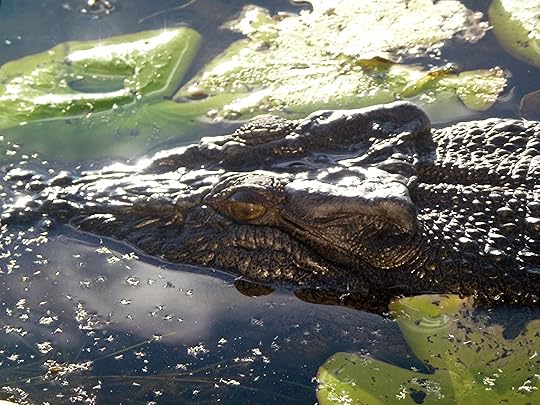
I read every article on local geography I could get my hands on before my first visit. Being in close proximity to a number of Aussies brought me a wealth of additional information. The only difficulty was sorting fact from fiction. One couple provided in-depth information on the pros and cons of the inner and outer Great Barrier Reef sections. Another implied that Queensland was practically riddled with “salties”−giant saltwater crocodiles−and even the birds were known for their precise dive-bombing skills. While the latter is no doubt true, there are ways of minimizing nearly every wildlife threat, you just have to figure out what they are.
During my first stop in Western Australia, I learned about the dreaded Ringtail Snakes and the ferocious Drop Bears. The snake is known for its ability to twist itself into a shape resembling a bicycle wheel to chase after you more quickly. Drop Bears are the not-so-cuddly cousin of the koala, equipped with vampire fangs and known to drop from Eucalyptus trees onto unwitting victims. Both species are known to specifically target tourists. I gave these stories a millisecond of credibility before I figured out that these wild tales were an example of the well-known Aussie sense of humor, but regardless, Googling “drop bears” provided decent entertainment.
When I relocated Down Under a few years later, I was a kid in a candy store. A lover of outdoor adventure, I could barely be contained. There was so much to explore and I often went solo. On South Australia’s Kangaroo Island, one of the most pristine wildlife habitats I have seen on this planet, I enjoyed a rocky coastal walk. Lost in my attempt to photograph dolphin pods along the shoreline and the notoriously shy Black Cockatoo, I failed to watch were I was going. The black mossy rocks could have been an oil slick for all the footing I could gain. I was on my backside in seconds. Being alone in Australia means being alone−as in not a soul to be seen for miles. Had I struck my head on those rocks, I would have floated out to see without anyone the wiser. I made myself a mental note to be more careful.
In my home state of Queensland, the magnificent beaches are magnetic. Few can resist them for long. I plunged into the Sunshine Coast waters every chance I could, only learning about the numerous species of evil jellyfish after the fact. They range from the barely visible but lethal Irukandji to the rare but insanely deadly Box Jellyfish−capable of killing 60 men in one go. Learning this, more notes were added to my growing tome of Australian outdoor code-of-conduct.
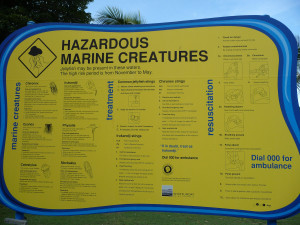 Eventually, with a few Australian years under my belt, I began to think, “I’ve got this!” I knew in what month the “jellies” would invade our beaches. I had seen two of the deadliest species of snakes in Australia, the Red-Bellied Black Snake and the Eastern Brown, and lived to tell the tales. I knew when torrential rain, known efficiently as the Big Wet, could be relied on to spoil outdoor fun. I believed I had the hang of it. When my good friend visited from New Jersey, I had to show her the best we had to offer.
Eventually, with a few Australian years under my belt, I began to think, “I’ve got this!” I knew in what month the “jellies” would invade our beaches. I had seen two of the deadliest species of snakes in Australia, the Red-Bellied Black Snake and the Eastern Brown, and lived to tell the tales. I knew when torrential rain, known efficiently as the Big Wet, could be relied on to spoil outdoor fun. I believed I had the hang of it. When my good friend visited from New Jersey, I had to show her the best we had to offer.
We rented a small powerboat to cruise the Noosa River. When it comes to boating, I would always prefer to be in the water rather than on it, so before long, the boat was pulled onto a small beach and I was plunging in headfirst. Perhaps it was the insane Queensland heat, but I took no notice of a few key factors in my haste. One, we were quite close to a gap in the shoreline that led into the ocean. Two, the high winds that day had whipped up a serious current. I had heard the word “riptide” but didn’t know exactly what it meant. I was about to learn that lesson.
My saviour was a calm bearded Kiwi in a “tinny”, an aluminum dinghy. He called out, “Are you in trouble?” and miraculously understood my affirmative garbled reply. Within minutes, he was instructing me to grab hold of the side of the boat and was pulling me ashore. After I thanked him profusely, all he said was “No worries. I don’t like fishing much anyway.”
Notes to Self: When sucked into a rip, stop trying to fight it and let it pull you to where it wants to. Otherwise, you expend your energy fighting it and will quickly exhaust yourself and drown.
Nearly five years into this game, my notes could fill a book. I‘ve never lived anywhere where there are so many possible ways to do yourself in and so many creatures willing to assist you. Nonetheless, I’ve never had so much joyful adventure anywhere else either. Let Darwinian Law reign supreme because if I go, at least I’ll go happy−no doubt with an Aussie nearby trying to turn my demise into his next favorite joke.
Originally posted on ExpatFocus.com ~ Columnist Jennifer Burge on Expat Focus
The post Is Australia Really Trying to Kill Me? appeared first on Worldwise Publications.
January 13, 2016
Where the Buffalo Roam
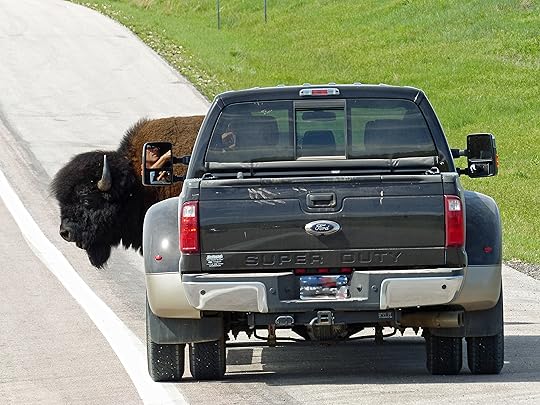
South Dakota lies below North Dakota. That was the extent of my knowledge of it. People who are not from the United States assume that we are all experts on our massive country, but I will brazenly admit this is not so. I am plenty familiar with my home state of Ohio and the ones that surround it. Having lived in Arizona, I also can claim credit for a certain amount of knowledge of the Southwest. Beyond that I am a tourist, so when my good friend proposed a road trip from her home in Nebraska to South Dakota last summer, I was thrilled about the opportunity to fill in the blanks.
Our first stop was Carhenge, a replica of Stonehenge made from junked cars. “Of course it’s real!” she said when I wondered aloud if she was pulling my leg. She wasn’t joking and we were far from the only people there to see it. Everyone, myself included, walked around it with the zombie-like stare of people who can’t quite interpret what their eyes leading them to believe. It is weird and wondrous at once and opened the door to an intriguing question: What else is out here that I never heard of? I would quickly find out.
Next on the itinerary was Custer State Park and the Mammoth Site. As a big fan of wildlife and US National Parks, I was very excited about the prospect of seeing live buffalo. I tried to keep my expectations in check, however, because wild animals are so unpredictable. As much as I would like to believe they’d show up for me, reality is often different. Imagine my surprise when we drove through the park gates and within minutes spotted five of the enormous animals grazing in a grassy meadow! Photos were immediately captured and knowing we would have more time to roam in the park, we moved on to the Mammoth Site.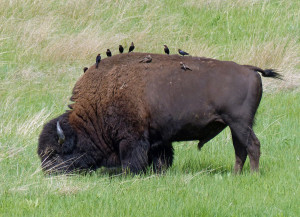
In Hot Springs, South Dakota, there lies a place so fascinating that fully-loaded tour buses fill the parking lot all day long. The unique draw of this location is that it holds the perfectly preserved remains of Columbian and Woolly Mammoths as well as other creatures that lived on planet Earth 26,000 years ago. Remarkable is not too strong of a word to describe what visitors see here. The explanation is that it is a kind of sinkhole that collapsed under the weight of these animals and they remained trapped inside for eternity. These bones must be seen to be believed, both for their pristine preservation as well as their unusual shapes.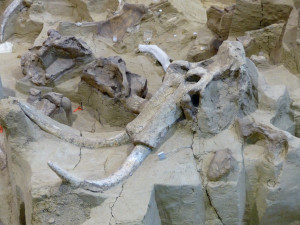
It blew my mind, this miracle uncovered by a construction worker in 1974 that I had never heard of. Though I was somewhat embarrassed by my lack of knowledge, I couldn’t wait to see what the road had yet to offer. As it turned out, Custer State Park is loaded with buffalo and they are huge. On the road near Wind Cave National Park, we hit a traffic jam. Most of the obstacles were brown and fur-covered, but there were several cars patiently waiting to cross when the buffalo had made their point and moved on. The point is that you cannot move a buffalo that doesn’t want to be moved! The mini-traffic jams throughout these intertwined parks are many, each one a photo opportunity not to be believed.
What next?? You ask! The scenic drive of Iron Mountain Road was next. This curvaceous, chipmunk-ridden, tunnel-laden beauty is one of the most beautiful roadways in the Black Hills. We stopped so many times on the way for photos that I nearly forgot our destination—striking Mount Rushmore. As we climbed up Iron Mountain Road, we were passed by clusters of bikers and I envied their freedom. It seemed appropriate that we were on our way to the monument which is the epitome of American independence.
Full disclosure: I didn’t expect to be impressed by Mount Rushmore. I will basically go on any road trip others are willing to take me on, but I thought the other sights would prove far more interesting. Perhaps it is because I underestimated it that it was so striking to me. It is strategically developed to maximize anticipation, urging Americans to locate flags and memorials to the year their state entered the union on the way to the main feature of the four former US presidents: Washington, Jefferson, Roosevelt, & Lincoln. I think for any American, it is a moving experience. For one that doesn’t get reminded daily of her American heritage, it was even more so.
But it was the last stop that did me in, a visit to the Crazy Horse Memorial. Crazy Horse was a great leader of the Lakota tribe. Chief Henry Standing Bear commissioned this mountain-sized work of art in his likeness and invited Polish artist Korczak Ziolkowski to create it in 1947. It is intended as a lasting monument to the subjugation of native cultures and minorities and as such takes no money from the United States government to fund its progression. The striking contradiction between the glorious, perfectly-constructed monument to the founding fathers of the United States and the slow progression of Crazy Horse’s raw power being pulled from mountain stone will never leave me. It is a “must see” in every sense of the word.
If your opinion of South Dakota is anything like mine was, I highly recommend this itinerary. It will forever change your view of the American west. Maybe you won’t enjoy a buffalo burger quite as much as I did and you won’t be charmed by sitting at an antique bar in an old saloon, but I’d venture a guess that most people will get something out of this journey that they didn’t anticipate. If I’m wrong, it’s just fine with me. That’s one less car between me and my buffalo.
The post Where the Buffalo Roam appeared first on Worldwise Publications.

